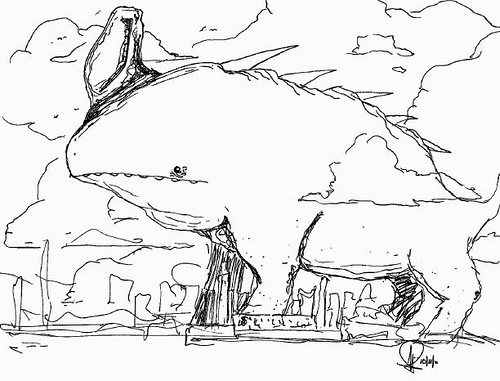Confluence, Convergence, and Layering

(Does this pertain to Mormeck, the writing book, critiques, or all three? With what did it originate, and where will it end up? I'm sure the illustrator, Jeremy Zerfoss, would like to know.)
Writing an online fiction serial like Mormeck as I've started working on the heavily visual creative writing book for Abrams, which includes re-reading a lot of my own nonfiction and that of others, while also doing some novel critiques has been an interesting experience. I descend through sedimentary layers throughout the day, adhering to a work schedule that separates out these different elements. But, of course, these disparate ways of engaging with narrative bleed into one another, inform one another, and spark ideas across projects.
For example, the novel critiques combined with the writing book research have made me re-evaluate the idea of distance in Mormeck. I'm more and more convinced that in the final draft there will be no "Stalingrad" but only "the winter city" and that in making the historical specificity more general I will bring into focus and make more specific other elements that are more general now. This is important to a narrative that acknowledges hundreds of alternate realities and inhabits several of them. When there are so many iterations of place and situation, the one observing this is perhaps less concerned with the extent of the deviation and more concerned with the personal relationships within that landscape…since the landscape is in a sense an illusion. This was brought home to me when writing the last avatar scene involving a German general. The fact of using a historical figure in the scene stifled a sense of character for me, even with the option of non-standard deviation. The character became encased in a kind of rigid armor, and indeed the reason he sits so stiff when the avatar reveals himself is not just from fear but also from the author's inability to imagine any other action for him.
Another thing that becomes clear from most novel critiques is that beginning writers struggle with how to convey information, especially in SF novels, even in later drafts. It is very hard for beginners to layer in exposition, and to make it a knife point that supports the blade of the characters and plot. When doing a serial, this takes a slightly different form, especially since the idea with Mormeck was to take delight in presenting unusual exposition—to in a sense make the exposition tell its own stories, so that even as this telling is pushing forward with the plot-intertwined-with-characters safely inside its whirring horizontal tornado, the circular force of exposition is itself made of narrative too. No, the problem instead is that particular thoughts, feelings, and actions by the characters at times take on a repetitive feel because I think of something too late and must revisit a context in a later scene to express it. Similarly, scenes that should in the final contract are expanded and over-exposed while other scenes are too short, their brevity birthing scenes later to compensate that would themselves be annexed by other scenes.
The writing books I'm re-reading, including one on subtext and another on the nature of influence between writers, help give further clarity to certain critiques, and at the same time in the anecdotes and situations suggest at times sublimation into fiction, the better to be grist for Mormeck, ground down and reformed in a harder, more concentrated form.
Structures that suggest themselves in Mormeck on a physical level in the form of creatures and objects begin to suggest images for the writing book—images that can contain or accommodate transformation from flesh-and-blood into metaphor (sometimes retaining their subtext from Mormeck) or more literal form-skeletons upon which to drap a point.
In some ways, too, the critiques—by requiring me to find alternate ways to say or structure or convey or imply for the betterment of the story—allow me to work out problems to solve in Mormeck on a practice field of sorts, the Mormeck-ghost attaching itself to the critique-novel context and when one is solved, so is the other, and the ghost, healed, releases, to float off to rejoin the rest of Mormeck-in-my-head.
These are imprecise and sometimes strangely heightened ways of talking about influence within one's own skull, but the point is that I think all of these disparate yet related activities are useful to one another, whereas they could have been disruptive.
Confluence, Convergence, and Layering originally appeared on Ecstatic Days on October 12, 2011.



